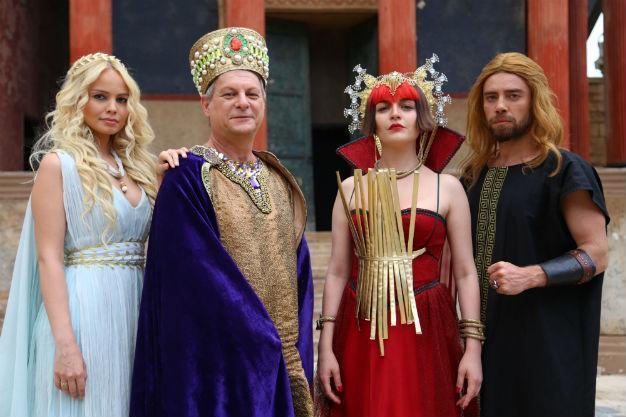The forgotten Byzantine Empire rescued Turkish cinema
Emrah Güler
 Trust Turkish filmmakers to resurrect the Byzantine Empire to play the much-needed enemy once every decade. Satirist and writer Gani Müjde returns to directing, satirizing where he feels at home, the depiction of Byzantines in Turkish cinema. Müjde’s “Bizans Oyunları: Geym of Bizans” (Byzantine Games: Game of Byzantine), released this week, pokes fun at the historical-action films from the 1950s to the 1970s which established the Byzantines as the ultimate enemy, a uniquely fictitious empire save its name.
Trust Turkish filmmakers to resurrect the Byzantine Empire to play the much-needed enemy once every decade. Satirist and writer Gani Müjde returns to directing, satirizing where he feels at home, the depiction of Byzantines in Turkish cinema. Müjde’s “Bizans Oyunları: Geym of Bizans” (Byzantine Games: Game of Byzantine), released this week, pokes fun at the historical-action films from the 1950s to the 1970s which established the Byzantines as the ultimate enemy, a uniquely fictitious empire save its name.The reign (and fall) of the Byzantine Empire was a popular backdrop for dozens of films for two decades beginning in the early 1950s, not only in historical epics but also in action-adventures and the films that fall into the genre of what we now call fantastic Turkish cinema, B-movies with over-the-top plotlines with a touch of the surreal.
Nationalism, patriotism and the ideal of heroism in Turkish cinema were defined and redefined for two decades thanks to the Byzantine Empire. It would be fair to say Turkish films of the period (and others who followed its predecessors’ steps in the subsequent decades) had only one sane connection with reality: That the Ottomans had conquered what was left of the great Byzantine Empire.
The Byzantines had one simple function in the storylines, providing a mightier-than-thou enemy for the heroic Turks - and a chance to include flashy costumes and barely-clad women. The evil that the Byzantines symbolized was summarized with two immortal words on screen, the “kahpe Bizans” (perfidious Byzantine).
Almost all of the Byzantine films were set in Istanbul (or Constantinople), but in a totally unique Istanbul where no historical accounts would justify this fictitious place. Similar to Transylvania, the supreme home town of vampires, this real city soon transformed into a barely recognizable fairy tale land.
Devious Byzantine priest vs. virtuous Muslim
Giovanni Scognamillo’s and Metin Demirhan’s reference book “Fantastik Turk Sinemasi” (Fantastic Turkish Cinema) lists Aydin Arakon’s “Istanbul’un Fethi” (The Conquest of Istanbul) in 1951 as the first film to put the Byzantine Empire into its storyline. Here we see the first figures of the devious and scheming Byzantine, whom, without the blink of an eye, killed, tortured, raped and consumed inhumane amounts of alcohol. The devious Byzantine priest as an antithesis to the virtuous Muslim also made its debut in Arakon’s film.
The early Byzantine historical-action films began with the adaptation of the historic Turkish nationalist comic books of the period, epitomized by “Karaoğlan” (Black Boy), and including such heroes as Kara Murat and Battal Gazi. These heroes had little to do with historical accuracy; their heroic tales were boosted with mightier enemies. While Turkish heroes shared more than their fair share of fighting anyone from Vikings to aliens, the Byzantines proved to be the most convenient, as well as the most popular.
The historical-action films were popular until the second half of the 1970s, eventually losing their popularity to the booming Turkish erotica onscreen. Even the Palme d’Or winner, the great Turkish-Kurdish filmmaker Yılmaz Güney, recreated nationalism through the Byzantines in two of his films in the 1960s, “Yedi Dağın Aslanı” (The Lion of the Seven Mountains) and “Aslanların Dönüşü” (The Return of the Lions). Both dated 1966, the two films took the Hollywood Western as their backbone, recreating the Wild West in Anatolia during the Byzantine reign.
The Byzantine reign once again resurrected in Turkish cinema in the late 1990s with a love story in the Byzantine Empire under siege, Ersin Pertan’s “Kuşatma Altında Aşk” (Love Under Surrender) of 1997. Three years later came satirist Gani Müjde’s directorial debut “Kahpe Bizans” (Harlot Byzantine), poking fun at the historical-action films of the yore. A decade and a half later, Müjde now returns to directing from where he left off, again with a spoof of the depiction of Byzantines in cinema. There is nothing fresh and subtle in “Bizans Oyunları;” it’s best to watch the original films where there was nothing subtle, but an abundance of freshness.
















